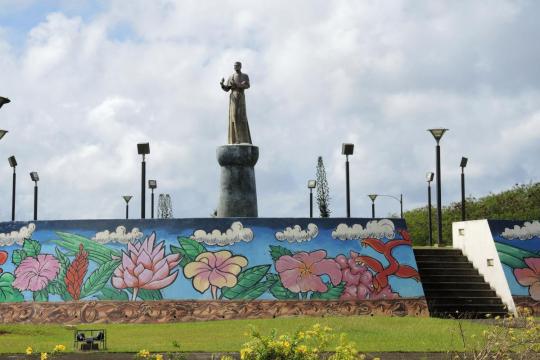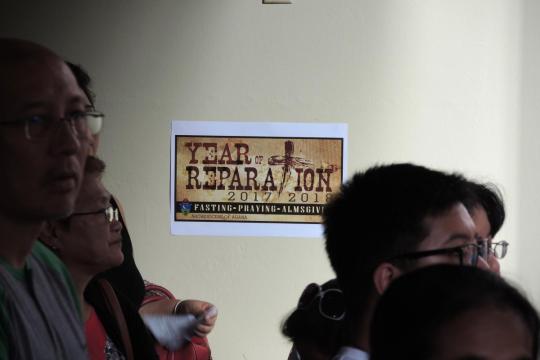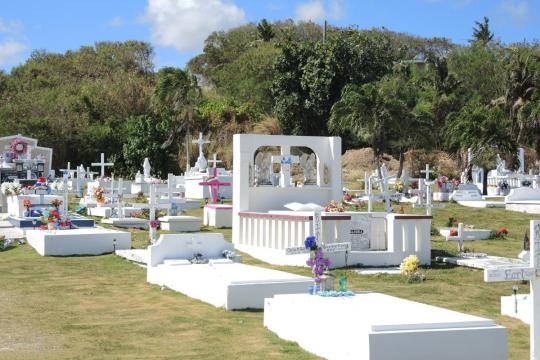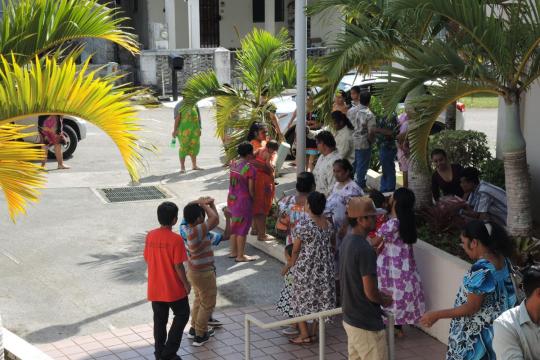
Like Puerto Rico and the U.S. Virgin Islands, Guam is a US territory, though not a state. It is listed separately here to make it easily searchable and to acknowledge its distinct and enduring cultural identity.
A U.S. territory in the far west Pacific, Guam is the native island of Chamorros, whose culture weaves aspects their own pre-colonial values with influences of Spaniards, Filipinos, Mexicans and mainland Americans. Chamorro identity has long been deeply intertwined with Catholicism, and still is, though Guam is a pluralistic society and its economy relies on the U.S. military bases there and tourism from several parts of East Asia.
Attraction to prosperity is transforming the island population over time: many Chamorros have moved to the mainland, while Filipinos and Micronesians have taken their place, making Chamorros a minority on their own island. Still, their values shape the Church. Chamorros hold tight to what is most important — family, respect for elders, faith, and respect for the dead. The ideal of Catholic practice in Guam is “respectful, not ostentatious.”
Guam’s matrilineal history is manifest in the roles women are traditionally granted as techas, prayer leaders for particular occasions; in the primacy of Marian devotion, particularly to Our Lady of Kamalen, regarded as patroness and protector of the island; and in the religious importance of promesas and intregas, promises passed down across generations of women to carry on particular devotions.
In the last several years, Guam has struggled through a major sexual abuse crisis that has caught up its now-deposed bishop, but it has not affected participation in the Church as it has in places like Ireland and the United States. Read more...
National Demographics
- 1 United Nations, Department of Economic and Social Affairs, Population Division, World Urbanization Prospects: The 2018 Revision, Online Edition (New York: United Nations, 2018).
- 2 United Nations, Department of Economic and Social Affairs, Population Division, International Migrant Stock 2020 (New York: United Nations, 2020).
- 3 Data as of 2021. United Nations Office on Drugs and Crime, "Intentional Homicide," United Nations, Accessed April 9, 2024; United Nations Office on Drugs and Crime, Global Study on Homicide 2023 (Vienna: United Nations, 2023).
- 4 "2023 Corruption Perceptions Index," Transparency International, Accessed April 9, 2024.
- 5 United Nations Children's Fund, The State of the World's Children 2023 (Florence: UNICEF Innocenti – Global Office of Research and Foresight, 2023).
- 6 International Telecommunication Union, "Individuals using the Internet (% of population)," The World Bank, Accessed April 24, 2024.
- 7 Poverty and Inequality Platform, "Poverty headcount ratio at $2.15 a day (2017 PPP) (% of population)," The World Bank, Accessed April 24, 2024.
- 8 World Economic Forum, Global Gender Gap Report 2023 (Geneva: World Economic Forum, 2023).
- 9 As Pew describes it, "Government restrictions on religion include laws, policies and actions that regulate and limit religious beliefs and practices. They also include policies that single out certain religious groups or ban certain practices; the granting of benefits to some religious groups but not others; and bureaucratic rules that require religious groups to register to receive benefits." As noted on pp. 45-47 of the report, the index summarizes data from 19 sources. The index does not differentiate whether the laws are directed toward Catholics. Pew Research Center, Globally, Government Restrictions on Religion Reached Peak Levels in 2021, While Social Hostilities Went Down (Pew Research Center, 2024).
- 10 As Pew describes it, "Social hostilities include actions by private individuals or groups that target religious groups; they also include actions by groups or individuals who use religion to restrict others. The SHI captures events such as religion-related harassment, mob violence, terrorism/militant activity, and hostilities over religious conversions or the wearing of religious symbols and clothing." As noted on pp. 45-47 of the report, the index summarizes data from 19 sources. The index does not differentiate whether the hostilities are directed toward Catholics. Pew Research Center, Globally, Government Restrictions on Religion Reached Peak Levels in 2021, While Social Hostilities Went Down (Pew Research Center, 2024).
Catholic Demographics
These statistics are derived from the Vatican's official publication, Statistical Yearbook of the Church 2022 (Vatican City: Librera Editrice Vaticana, 2024). The numbers may differ from data reported by other sources on this site.





